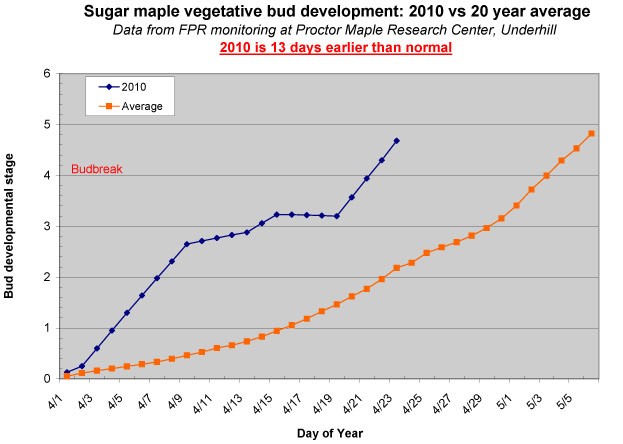Have things seemed early to you this year? Early buds? Early peepers? Early trips to the drugstore to buy Claritin?
Turns out your hunch is accurate, at least about the buds and the Claritin.
Tom Simmons and colleagues at the Vermont Department of Forests, Parks, and Recreation have been monitoring sugar maple bud break at the Proctor Center in Underhill Center, Vermont, since 1991. The researchers’ primary goal is to monitor pear thrip populations, but their data also prove useful in tracking weather anomalies.
In the accompanying chart, you’ll see the evolution of this year’s sugar maple buds, in blue, compared against the 20-year average, in orange. The numbers on the vertical axes refer to different stages in a bud’s development. One is the initial bud swell, two is extended bud swell, three is when the bud scales begin to separate and green starts to show, four is “budbreak,” when the bud scales have fully separated, five is when the peduncles, or stalks, of the tree flowers extend, six is when the leaves begin to appear.
As you can see, everything is dramatically ahead of schedule this year.
It all leads to the question of what this is going to do to the trees. Simmons says that he has noticed some slight frost damage on leaves, but he says that this is not out of the ordinary. And barring anything really freaky, it seems that the trees are out of the woods by now. Like pear thrips, frost is most damaging in bud stages four and five, when everything is compressed. He analogized it to folding a paper into a tight square, and then cutting into it with scissors. Once a leaf has fully opened, which most have by now, late frosts can nip at the edges, but the damage is more dispersed and more easily absorbed.
One interesting question is whether the head start will help the trees, and Simmons says he doesn’t see why it wouldn’t. Assuming the weather returns to normal patterns, which may be assuming a lot, thirteen extra growing days are thirteen extra growing days.



Discussion *